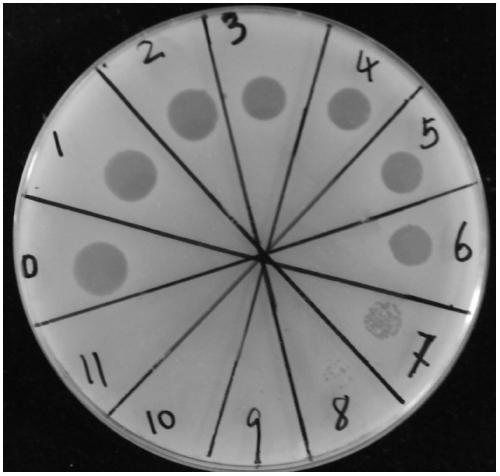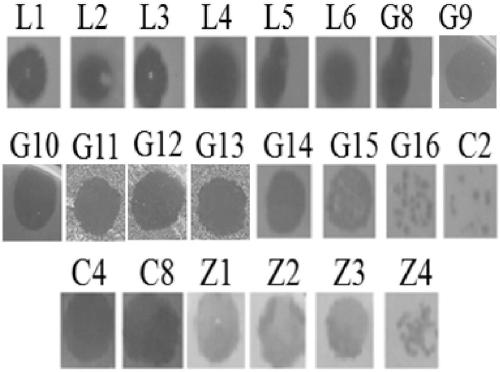Application of Acidovorax avenae subsp.avenae phage and biocontrol agent
A technology of brown streak bacteria and biocontrol agents, applied in the direction of virus/bacteriophage, phage, application, etc.
- Summary
- Abstract
- Description
- Claims
- Application Information
AI Technical Summary
Problems solved by technology
Method used
Image
Examples
Embodiment 1
[0021] The bacteriophage AP1 of the rice bacterial brown streak pathogen, the preservation number is CCTCC M 2014599, was obtained by the applicant in the previous experiment. For related information, please refer to the Chinese invention patent with the publication number CN104630154A.
[0022] Rice bacterial blight (Xanthomonas oryzae subsp.oryzae, Xoo for short), of which 6 strains were isolated from Liaoning (L1-L6), 4 strains were isolated from Zhejiang (Z1-Z4), and 12 strains were isolated from Guangdong Province. Diseased plants (G8~G16, C2, C4, C8).
[0023] Pick a single colony of fresh bacterial blight of rice, place it in 5ml of NA liquid medium, and cultivate it in a constant temperature shaker with a rotation speed of 200rpm at 30°C until the bacterial concentration is about 10 8 cfu / ml; take 1ml of the bacterial solution to a new 5ml NA medium, add 6μl concentration of 10 9 pfu / ml of AP1 phage ( figure 1 : 0-11 respectively represent 10-fold gradient dilution o...
Embodiment 2
[0025] Mix 5ml of NA semi-solid medium (cooled to about 50°C) with 1ml of rice bacterial blight suspension (10 8 cfu / ml) were mixed evenly, spread on the NA solid medium to make the creep of Xoo bacteria, and set aside after solidification.
[0026] 2 μl of the lysate with different concentrations prepared in Example 1 was dropped onto the bacteria plate of Xoo bacteria, dried in the air, and incubated in a constant temperature incubator at 30° C. for 24 hours.
[0027] Judgment on the successful induction of the lysogenic / lytic cycle transition of the rice bacterial blight prophage: 22 strains were isolated from rice bacterial blight in Liaoning, Zhejiang and Guangdong, and the lysates produced transparent phages after co-cultivation spot( figure 2 ).
Embodiment 3
[0029] Specific primers were designed by using the conserved gene of exogenous phage AP1 to rule out the judgment of AP1 self-amplification and reproduction: bands could be detected in AP1, but no bands could be detected in the induced release phage. The specific primers for the AP1 conserved gene, the nucleotide sequences of which are:
[0030] Upstream primer F1: 5'-ATAGGATCCATGAAGTTCTACGCCCCCACCG-3',
[0031] Downstream primer R1: 5'-TGTCAGTCGACTCAGCCGTTCACGTCTTCGAAG-3'.
[0032] The sequence fragment obtained by using F1 and R1 to amplify AP1 is shown in SEQ ID No.1, and the fragment length is 395bp.
[0033] PCR detection system:
[0034] 2×T5 Super PCR mix enzyme
10μL
10μmol / L upstream and downstream primers
1μL each
template
1μL
Sterilized double distilled water
7μL
total
20 μL
[0035]PCR reaction conditions: pre-denaturation at 98°C for 10min; denaturation at 98°C for 30S, annealing at 60°C for 20S, exte...
PUM
 Login to View More
Login to View More Abstract
Description
Claims
Application Information
 Login to View More
Login to View More - R&D
- Intellectual Property
- Life Sciences
- Materials
- Tech Scout
- Unparalleled Data Quality
- Higher Quality Content
- 60% Fewer Hallucinations
Browse by: Latest US Patents, China's latest patents, Technical Efficacy Thesaurus, Application Domain, Technology Topic, Popular Technical Reports.
© 2025 PatSnap. All rights reserved.Legal|Privacy policy|Modern Slavery Act Transparency Statement|Sitemap|About US| Contact US: help@patsnap.com



